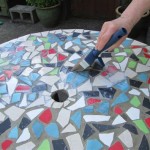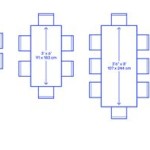How Many Chairs Fit At a 60-Inch Round Table
Determining the appropriate number of chairs to place around a 60-inch round table is a common concern for event planners, restaurant owners, and homeowners alike. The answer is not simply a matter of dividing the circumference by a chair width; several factors influence the ideal seating capacity for such a table. Comfort, functionality, and the nature of the event or gathering all play crucial roles in optimizing the seating arrangement. Overcrowding can lead to discomfort and hinder movement, while too few chairs can make the space feel sparse and underutilized. Therefore, a careful assessment of these contributing elements is essential to achieving a balanced and practical seating configuration.
A 60-inch round table, which measures five feet in diameter, offers a versatile surface area suitable for a variety of purposes. However, its usability is directly related to the number of individuals it can comfortably accommodate. This article will explore the key considerations involved in determining the optimal chair count for a 60-inch round table to ensure a pleasant and functional setting.
Understanding Minimum Space Requirements Per Person
The foundation for determining seating capacity rests on understanding the minimum space required for each person at the table. This isn't just about physical width; it encompasses the space needed for comfortable elbow room, movement during the meal or activity, and general personal space. A generally accepted guideline suggests allocating between 24 and 30 inches of table space per person.
The lower end, 24 inches, might be acceptable for casual gatherings or situations where people are not expected to spend extended periods seated. This spacing allows for a tighter arrangement, suitable for buffet-style meals or informal meetings. However, this can feel cramped, especially if the plates and serving dishes are large.
The higher end, 30 inches, offers significantly more personal space and is better suited for formal dinners, banquets, or events where comfort is a priority. This allows for more room to maneuver, larger place settings, and a more relaxed atmosphere. This extra space contributes significantly to a more comfortable and enjoyable experience for each guest.
Applying these guidelines to a 60-inch round table helps narrow down the potential chair count. To calculate the approximate circumference of the table, use the formula: Circumference = π (pi) x diameter. Using 3.14 as an approximation for pi, the circumference of a 60-inch table is approximately 188.4 inches. Dividing this circumference by the minimum space requirements provides an estimated seating capacity. Therefore, 188.4 inches divided by 24 inches per person equals approximately 7.85, suggesting a possibility of seating around 7-8 people in a tightly packed arrangement. Dividing 188.4 inches by 30 inches per person equals approximately 6.28, suggesting a more comfortable seating arrangement for around 6 people.
The Impact of Chair Size and Style on Seating Capacity
While calculating based on circumference provides a starting point, the actual size and style of the chairs significantly impact the final seating capacity. Chairs come in various widths, arm styles, and overall designs. A chair with wide arms will obviously consume more space than a chair with no arms or narrow arms. Conversely, a chair with a smaller footprint allows for denser seating arrangements.
Standard dining chairs typically range from 18 to 22 inches in width. Chairs with arms often require more space, potentially adding several inches to the overall width. The depth of the chair, from the front of the seat to the back, is also a relevant factor, particularly concerning the overall flow around the table. Narrower chairs might allow for an extra person, while wider chairs will decrease the overall seating capacity.
Folding chairs, often narrower and more compact, can be a suitable option for maximizing seating, especially in situations where space is limited. However, they may not be as comfortable for extended periods as more substantial dining chairs. Chiavari chairs and other ballroom chairs tend to have specific widths, typically ranging from 15 to 18 inches, and their design can influence how closely they can be placed together.
Considering the chair style involves more than just width. The angle of the chair back, the presence of any decorative elements, and the overall profile can impact how much space the chair occupies around the table. When planning an event or setting up a dining space, physically measuring the chairs being used and considering their overall dimensions in relation to the table is crucial for accurate seating arrangements. For instance, if you are using chairs that are 20 inches wide with arms, it's unlikely that you will be able to comfortably fit 8 people around the table, even if the circumference calculation suggests it.
Accounting for Table Setting and Event Type
The type of event and the complexity of the table setting also affect the ideal number of chairs to place around a 60-inch round table. A formal dinner with multiple courses and elaborate tableware requires more space per person than a casual buffet-style meal or a simple meeting. The larger the table setting, the more space needed to avoid crowding and ensure that guests have ample room to eat and converse comfortably.
Formal settings often include chargers, multiple glasses, bread plates, and various utensils, all of which contribute to the clutter on the table. If you are planning a formal dinner with elaborate settings, it's best to aim for the lower end of the seating capacity range, typically 6 chairs, to prevent the table from feeling overwhelmed. In contrast, a casual buffet may only require a single plate and utensils, allowing for a slightly higher seating capacity of approximately 7 people.
The event type itself also plays a role. For example, a wedding reception might prioritize aesthetics and spacious seating arrangements, even if it means reducing the number of guests at each table. Business meetings, on the other hand, might prioritize functionality and maximizing the number of participants, even if it means a slightly tighter seating arrangement. The event’s specific requirements should guide the decision-making process regarding seating capacity.
If the table is to be used for activities other than dining, such as playing games or working on a project, the necessary space requirements may differ. The size of the materials, the amount of arm movement required, and the need for individual work areas all influence the optimal chair count. A table used for board games, for instance, will need adequate space for the board, game pieces, and elbow room for each player.
Ultimately, determining the proper number of chairs for a 60-inch round table demands a holistic approach, integrating dimensions, the style of chairs, and the purpose of the event or gathering. By carefully considering these elements, it is possible to make informed decisions that result in a comfortable and functional setting for all participants.
Factors like accessibility, the age and physical condition of the guests, and the overall ambiance also play subtle roles in the decision-making process. For example, if the event includes elderly guests or individuals with mobility issues, extra space should be allocated to ensure easy access to and from the table. Creating an inclusive environment that prioritizes comfort and safety is an essential aspect of event planning.
Lighting, decorations, and the overall layout of the room contribute to the user experience. Dimly lit environments might require additional space to prevent accidental bumps or spills, while overly crowded rooms can feel claustrophobic and unpleasant. Integrating these aspects into the planning process ensures a pleasant and functional gathering.
Finally, trial and error can be a useful tool for determining the optimal seating arrangement. If possible, set up the table with the chairs and table settings to get a visual sense of the space. Have people sit at the table to assess the comfort level and ease of movement. This hands-on approach can help identify any potential problems and fine-tune the seating configuration for a perfect fit. Determining the number of chairs for a 60-inch round table requires consideration of various factors, including individual space, chair size and style, and the event type. Carefully weighing these aspects will make gatherings a success for everybody attending.

Professional Table Seating Guide The Chiavari Chair Company

60 Round Table Seat 8 To 10 Destination Events

How Many Chairs Fit At A Table

60 Round Table Seat 8 To 10 Destination Events

60 In Round Table Mtb Event Als

The Right Number Of Chairs For Any Table Canadel S Blog

Round 60 Inch Table Al Customer Pick Up Option

Lifetime 60 Inch Round Table And 8 Chairs Combo

Wedding Planning Tools Table Sizes Seating Happily Connected

Reception Seating Big Tent Events
Related Posts








